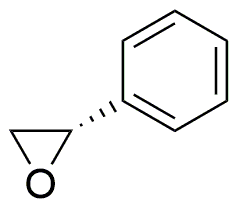(S)-Styrene oxide is widely utilized in research focused on
- Pharmaceuticals: This compound serves as a key intermediate in the synthesis of various pharmaceuticals, including anti-cancer agents and anti-inflammatory drugs, enhancing the efficiency of drug development processes.
- Polymer Production: It is used in the production of specialty polymers, providing unique properties such as improved thermal stability and chemical resistance, which are essential for applications in coatings and adhesives.
- Flavor and Fragrance Industry: (S)-Styrene oxide is employed in the synthesis of flavoring agents and fragrances, contributing to the production of appealing scents and tastes in consumer products.
- Research in Organic Chemistry: It serves as a valuable reagent in organic synthesis, facilitating the study of reaction mechanisms and the development of new synthetic methodologies, making it a staple in academic laboratories.
- Environmental Applications: The compound is investigated for its potential in environmental remediation processes, particularly in breaking down pollutants, thus supporting efforts in sustainable chemistry.
Informations générales
Propriétés
Sécurité et réglementation
Applications
(S)-Styrene oxide is widely utilized in research focused on
- Pharmaceuticals: This compound serves as a key intermediate in the synthesis of various pharmaceuticals, including anti-cancer agents and anti-inflammatory drugs, enhancing the efficiency of drug development processes.
- Polymer Production: It is used in the production of specialty polymers, providing unique properties such as improved thermal stability and chemical resistance, which are essential for applications in coatings and adhesives.
- Flavor and Fragrance Industry: (S)-Styrene oxide is employed in the synthesis of flavoring agents and fragrances, contributing to the production of appealing scents and tastes in consumer products.
- Research in Organic Chemistry: It serves as a valuable reagent in organic synthesis, facilitating the study of reaction mechanisms and the development of new synthetic methodologies, making it a staple in academic laboratories.
- Environmental Applications: The compound is investigated for its potential in environmental remediation processes, particularly in breaking down pollutants, thus supporting efforts in sustainable chemistry.
Documents
Fiches de données de sécurité (FDS)
La FDS fournit des informations de sécurité complètes sur la manipulation, le stockage et l’élimination du produit.
Spécifications du produit (PS)
Le PS fournit une description complète des propriétés du produit, notamment sa composition chimique, son état physique, sa pureté et les exigences de stockage. Il détaille également les plages de qualité acceptables et les applications prévues du produit.
Certificats d'analyse (COA)
Recherchez des certificats d'analyse (COA) en saisissant le numéro de lot du produit. Les numéros de lot et de lot se trouvent sur l'étiquette d'un produit, après les mots « Lot » ou « Lot de fabrication ».
Numéro de catalogue
Numéro de lot/série
Certificats d'origine (COO)
Ce certificat d'exploitation confirme le pays dans lequel le produit a été fabriqué, et détaille également les matériaux et composants utilisés et s'il est issu de sources naturelles, synthétiques ou autres sources spécifiques. Ce certificat peut être requis pour les douanes, le commerce et la conformité réglementaire.
Numéro de catalogue
Numéro de lot/série
Fiches de données de sécurité (FDS)
La FDS fournit des informations de sécurité complètes sur la manipulation, le stockage et l’élimination du produit.
DownloadSpécifications du produit (PS)
Le PS fournit une description complète des propriétés du produit, notamment sa composition chimique, son état physique, sa pureté et les exigences de stockage. Il détaille également les plages de qualité acceptables et les applications prévues du produit.
DownloadCertificats d'analyse (COA)
Recherchez des certificats d'analyse (COA) en saisissant le numéro de lot du produit. Les numéros de lot et de lot se trouvent sur l'étiquette d'un produit, après les mots « Lot » ou « Lot de fabrication ».
Numéro de catalogue
Numéro de lot/série
Certificats d'origine (COO)
Ce certificat d'exploitation confirme le pays dans lequel le produit a été fabriqué, et détaille également les matériaux et composants utilisés et s'il est issu de sources naturelles, synthétiques ou autres sources spécifiques. Ce certificat peut être requis pour les douanes, le commerce et la conformité réglementaire.


